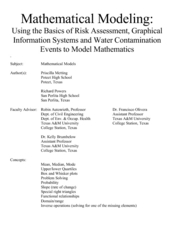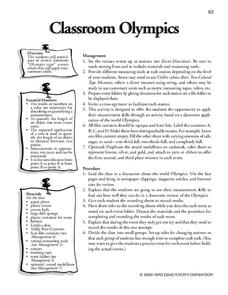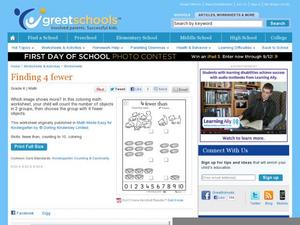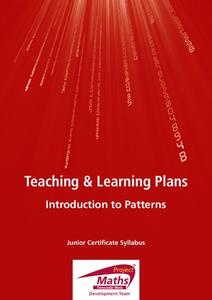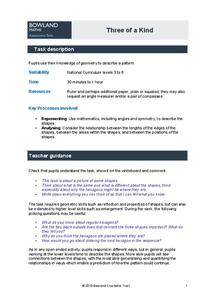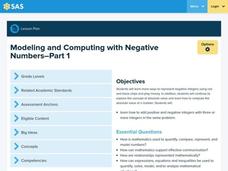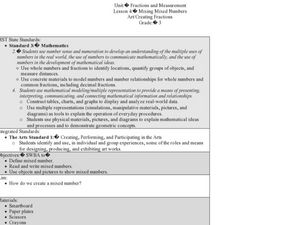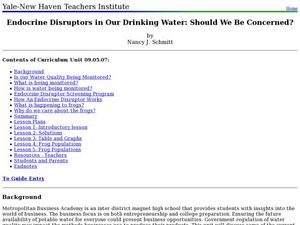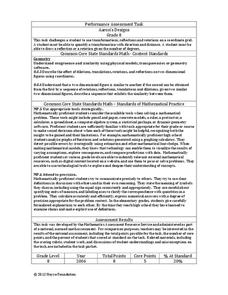Curated OER
Mathematical Modeling
Study various types of mathematical models in this math lesson plan. Learners calculate the slope to determine the risk in a situation described. They respond to a number of questions and analyze their statistical data. Then, they...
Curated OER
Stiochiometry: Quantifying Changes in the Environment
Students examine stoichiometry. In this chemical reaction and mole lesson, students complete an experiment based on readiness levels to explore that changes are quantified in chemical reactions.
Curated OER
More Than or Less Than?
How many apples is less than five? Each of these problems has two images, one with quantifiable details and one without (i.e. a tree with apples and an empty tree). Answers will vary as young counters draw objects onto the second image...
AIMS Education Foundation
Classroom Olympics
As the Summer Olympics are approaching, incorporate Olympic-type games into the classroom. From straw javelin to cotton ball shot put, these games are sure to keep leaners engaged. The best part is that there is math involved! Pupils...
EngageNY
Scale Factors
Is it bigger, or is it smaller—or maybe it's the same size? Individuals learn to describe enlargements and reductions and quantify the result. Lesson five in the series connects the creation of a dilated image to the result. Pupils...
EngageNY
Margin of Error When Estimating a Population Mean (part 1)
We know that sample data varies — it's time to quantify that variability! After calculating a sample mean, pupils calculate the margin of error. They repeat the process with a greater number of sample means and compare the results.
DK Publishing
4 Fewer Than
Which image has four fewer? There are three sets of objects here which introduce subtraction concepts to beginning mathematicians (although the word subtraction and its symbol do not show up here). They count the number of objects in...
Project Maths
Introduction to Patterns
The world is full of patterns. Help learners quantify those patterns with mathematical representations. The first Algebra lesson in a compilation of four uses a series of activities to build the concept of patterns using multiple...
Curated OER
Counting: Connecting Pictures and Numbers
As young scholars begin connecting numbers with values, help them grasp this concept with sets of objects like these. They examine five sets (up to 15 in number) and match each to a corresponding digit. Then, they draw a set of their own...
Willow Tree
Approximating a Line of Best Fit
You may be able to see patterns visually, but mathematics quantifies them. Here learners find correlation in scatterplots and write equations to represent that relationship. They fit a line to the data, find two points on the line, and...
Curated OER
Representing Objects with Numbers (0 to 20) Guided Lesson
Here are a few opportunities for youngsters to hone their number skills by counting and quantifying objects, tracing numbers, and translating word-form numbers into numerical form. There are four questions here providing practice with...
Curated OER
Multiplication of Whole Numbers
Break up multiplication into more easily conceptualized math operations. Scholars first examine an array of apples and write a multiplication sentence to represent it. Then, they determine which of four sets of addends is equivalent to a...
Curated OER
Make Ten Guided Lesson
Use these missing-addend problems to help your beginning mathematicians practice addition facts. They read sentences and solve, making 10 from different single-digit numbers. Each of these four problems is formatted differently, so the...
Bowland
Three of a Kind
One is chance, two is a coincidence, three's a pattern. Scholars must determine similarities and differences of a regular hexagon undergoing dilation. They look at lengths, angles, areas, and symmetry.
Curated OER
Measuring to the Nearest Inch
Third graders use whole numbers and fractions to make connections between abstractions of the mathematical world and the real world. In this fractions and measurement lesson, 3rd graders identify, quantify groups , and measure distances....
Curated OER
Dividing with Fractions
Use paper strips or models to relate division problems to division of fraction problems. Since the materials can be broken up, it helps them to show how they can complete repeated subtraction with fractions and not just whole numbers.
Curated OER
Countable and Uncountable Nouns - Noun Quantifiers
Pupils solidify their knowledge of countable and uncountable nouns and their quantifiers. The instructional activity includes a number of overlooked or idiomatic expressions to help higher level students expand their knowledge.
101 Questions
Popcorn Picker
A video and popcorn, just like being at the movies! Given the dimensions of two different cylinders, scholars decide which will hold the most popcorn. They find out if their calculations are correct with the provided solution video.
Concord Consortium
Sharp-Ness of Bends
Define the sharpest in the group. Given a section of a trail map, pupils determine a method to measure the sharpness of each turn in the path. Individuals then determine what modifications to their formulas to make to find the sharpness...
Curated OER
Mixing Mixed Numbers Art/Creating Fractions
Third graders explore number values by participating in class math activities. In this fractions lesson, 3rd graders collaborate with classmates to discuss the technique of adding mix numbers while utilizing paper plates to help...
Curated OER
Endocrine Disruptors in Our Drinking Water: Should We Be Concerned?
Students investigate the different hormone contaminants in the water supply. In this math lesson, students analyze data tables and graphs. They demonstrate exponential growth and decay using frog populations.
Inside Mathematics
Graphs (2006)
When told to describe a line, do your pupils list its color, length, and which side is high or low? Use a instructional activity that engages scholars to properly label line graphs. It then requests two applied reasoning answers.
Inside Mathematics
How Old Are They?
Here is a (great) lesson on using parentheses! The task requires the expression of ages using algebraic expressions, including the distributive property. Pupils use their expressions to determine the individual ages.
Inside Mathematics
Aaron's Designs
Working with transformations allows the class to take a turn for the better. The short assessment has class members perform transformations on the coordinate plane. The translations, reflections, and rotations create pattern designs on...


